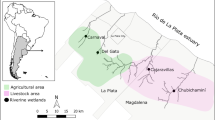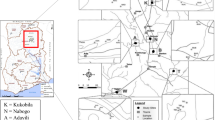Abstract
Ponnani Kole wetlands, the northward extension of Vembanad Kole Ramsar site in Kerala, Southern India, is facing environmental pressures due to increases in human population, changes in land use pattern, improper watershed management and urban developments. The current study describes the community assemblage pattern of macrophytes and their variations within and among areas affected by environmental disturbances in Ponnani Kole wetland system. The macrophyte community structures in the study site were characterized with reference to areas of saline intrusion, intense agricultural activities and sewage disposal. Sphaeranthus africanus and Colocasia esculenta were specific to sewage; Rotala indica, Hedyotis corymbosa, Limnophila heterophylla and Eriocaulon setaceum were specific to agriculture; while, Acanthus ilicifolius, and Mariscus dubius were specific to areas of saline intrusion in the study site. Mean diversity did not vary significantly among the different zones of disturbance with the exception of saline intruded areas. Taxonomically, similar species flourished well in all regions of the study except in the saline intrusion area. In undisturbed areas, considered as control, the occurrence of all macrophytes was observed in equal proportions with the exception of mangroves and suspended hydrophytes. However, in sewage disposal areas, the occurrence of 45 species was observed with unequal predominance of all taxa, viz. class, order and family of macrophytes. The implementation of decision supporting tools to aid strategy and policy makers explore land-use options and disturbance scenarios along with ecological tools assessing multiple ecosystem services will see Ponnani Kole wetland become established as a macrophyte dominated ecological regime which can be further developed as a conservation and educational site for tropical aquatic macrophytes.





Similar content being viewed by others
References
Anonymous (1996) Asia-Pacific water bird conservation strategy (1996-2000) wetlands international Asia-Pacific, Kualalumpur, publication no. 117 and International Waterfowl and Wetlands Research Bureau-Japan Committee, Tokyo
Camargo AFM, Pezzato MM, Henry-Silva GG (2003) Crescimento e Produção Primáriade Macrófitas Aquáticas em Zonas Litorâneas. In: Henry R (ed) Ecótonos nas interfacesdos ecossistemas aquáticos. Fundibio/Rima, São Carlos, pp 213–232
Capers RS (2003) Macrophyte colonization in a freshwater tidal wetland. Lyme, CT USA. Aquatic Botany 77:325–338
Chandra P, Kulshreshtha K (2004) Chromium accumulation and toxicity in aquatic vascular plants. Botanical Review 70:313–327
Clarke KR (1993) Non-parametric multivariate analyses of changes in community structure. Australian Journal of Ecology 18:117–143
Clarke KR, Warwick RM (1998) A taxonomic distinctness index and its statistical properties. Journal of Applied Ecology 35:523–531
Clarke KR, Warwick RM (2001) A further biodiversity index applicable to species lists: variation in taxonomic distinctness. Marine Ecology Progress Series 216:265–278
Connell JH (1978) Diversity in tropical rain forests and coral reefs. Science 199:1302–1309
Cronk JK, Fennessy MS (2001) Wetland plants: biology and ecology, Lewis Publ., Boca Raton: 462
Engehardt KAM, Ritchie ME (2002) The effect of aquatic plant species richness on wetland ecosystem processes. Ecology 83:2911–2924
Faliniski JB (2000) The interpretation of contemporary vegetation transformations on the basis of the theories of synanthropisation and syndynamics. In:Jackowiak B, Zukowski W (eds) Mechanism of anthropogenic changes of the plant cover, publications of the Department of Plant Taxonomy of the Adam Mickiewicz university, Poznan 10: 9–30
Feldmann T (2012) The structuring role of lake conditions for aquatic macrophytes [Ph.D. thesis]. Estonian university of life sciences, Tartu, p 182
Folke C, Carpenter SR, Walker B, Scheffer M (2004) Regime shifts, resilience and biodiversity in ecosystem management. Annual Review of Ecology, Evolution, and Systematics 35:557–581
Gamble JS (1915) The Flora of the presidency of madras Vol 1–3. Adlard and Son Ltd, London
Gettys LA, Haller WT, Bellaud M (2009) Biology and control of aquatic plants: a best management practices handbook, 2009. First published in the United States of America in 2009 by aquatic ecosystem restoration foundation, Marietta, Georgia, printed in Gainesville, Florida, USA, ISBN 978-0-615-32646-7
Goldyn H (2010) Changes in plant species diversity of aquatic ecosystems in the agricultural landscape in West Poland in the last 30 years. Biodiversity and Conservation 19:61–80
Grenouillet G, Pont D, Seip KL (2002) Abundance and species richness as a function of food resources and vegetation structure: juvenile fish assemblages in rivers. Ecography 25(6):641–650
Hart BT, Lake PS, Webb JA, Grace MR (2003) Ecological risk to aquatic systems from salinity increases. Australian Journal of Botany 51:689–702
Heino J, Soininen J, Lappalainen J, Virtanen R (2005) The relationship between species richness and taxonomic distinctness in freshwater organisms. imnology and Oceanography 50(3):978–986
Hooker JD (1897) Flora of British India Vol 1–6. London reprinted, Bishen Singh and Mahendra Pal Singh, Dehradun, India
IPNI (2009) International plant names index. Electronic database accessible at http://www.ipniorg/ipni/plant names search page.do
Jackowiak B (2003) Wspolczesne przemiany flory Wielkopolski w swietle hipotezy stepowienia. In: Banaszak J (ed) Stepowienie Wielkopolski-pol wieku pozniej. Kazimierz Wielki Bydgoska Academy Press, Bydgoszcz, pp 65–76
Jeppesen E, Sondergaard M, Christoffersen K (1998) The structuring role of submerged macrophytes in Lakes. Ecological Series 131: Springer- Verlang 423
Johnkutty I, Venugopal VK (1993) Kole lands of Kerala. Kerala Agricultural University, Vellanikkara, Thrissur
Lambshead PJD, Platt HM, Shaw KM (1983) The detection of differences among assemblages of marine benthic species based on an assessment of dominance and diversity. Journal of Natural History 17:859–874
Manilal KS, Sivarajan VV (1982) Flora of Calicut, Bishen Singh Mahendra Pal Singh. Dehradun, India
Millennium Ecosystem Assessment (2005) Ecosystems and human well-being: synthesis. Island Press, Washington, DC
Nameer PO (2002) Kole Wetlands- an internationally important wetland in Peril. Proceedings of the Fourteenth Kerala Science Congress 29–31 January: 627–630
Nielsen DL, Brock MA, Rees GN, Baldwin DS (2003) Effects of increasing salinity on fresh water ecosystems in Australia. Australian Journal of Botany 51:655–665
Owen CR (1999) Hydrology and history: land use changes and ecological responses in an urban wetland. Wetlands Ecology and Management 6:209–219
Pankhurst H (2005) Patterns in the distribution of aquatic Macrophytes in Georgian bay, Ontario, final report for senior Honours project submitted to: Department of Biology, McMaster University 1280 main street west. Hamilton, ON L8S 4K1
Papastergiadou E, Retalis A, Apostolakis A, Georgiadis T (2008) Environmental monitoring of spatio-temporal changes using remote sensing and GIS in a Mediterranean wetland of northern Greece. Water Resour Manage 22:579–594
Platt HM, Shaw KM, Lamshead PJD (1984) Nematode species abundance and their use in the detection of environmental perturbations. Hydrobiologia 118:59–66
Praveen J (2015) A checlist of birds of Kerala, India Journal of Threatened Taxa/www.threatenedtaxa. org: 7(13) 7983–8009
Reddy KR, De Busk WF (1985) Nutrient removal potential of selected aquatic macrophytes. Journal of Environmnetal Quality 14(4):459–462
Scheffer M, Jeppesen E (2007) Regime shifts in shallow lakes. Ecosystems 10:1–3
Shimoda M (2003) Suidennno seibutsu wo yomigaeraseru. Iwanamishoten, Tokyo Japan
Smith JE (2011) Algae, [in:] Simberloff D, Rejmanek M (eds) Encyclopedia of biological invasions, University of California Press. Los Angeles: 11–15
Southichak B, Nakano K, Nomura M, Chiba N, Nishimura N (2006) Phragmities australis: a novel biosorbent for the removal of heavy metals from aqueous solution. Water Research 37:2035–2042
Srinivasan TJ (2010) Understanding the Kole lands in Kerala as a multiple use wetland ecosystem. Working Paper No. 89, Research Unit for Livelihoods and Natural Resources Working Paper No. 5, Hyderabad, India. 1–36
Sunil CN, Sivadasan M (2009) Flora of Alappuzha District Kerala, India. Bishen Singh Mahendra Pal Singh, Dehradun, India 949
Tamire G, Mengistou S (2012) Macrophyte species composition, distribution and diversity in relation to some physicochemical factors in the littoral zone of Lake Ziway, Ethiopia. African Journal of Ecology 51:66–77
Thiebaut G, Muller S (1998) The impact of eutrophication on aquatic macrophyte diversity in weakly mineralized streams in the Northern Vosges mountains (NE France). Biodiversity and Conservation 7(8):1051–1068
Townsend CR, Scarsbrook MR, Doledec S (1997) The intermediate disturbance hypothesis, refugia, and biodiversity in streams. Limnology and Oceanography 42:938–949
Valerie TE, Chapin FS (2001) Plant species provide vital ecosystem functions for sustainable agriculture, rangeland management and restoration. California agriculture 55(6):54–59
Verhoeven JTA, Setter TL (2010) Agricultural use of wetlands: opportunities and limitations. Annals of Botany 105(1):155–163
Walker B, Kinzig A, Langridge J (1999) Plant attribute diversity, resilience and ecosystem function: the nature and significance of dominant and minor species. Ecosystems 2:95–113
Weller MW, Spatcher CE (1965) Role of habitat in the distribution and abundance of marsh birds. Iowa Agriculture and Home Economics Experiment Station, Special Report 43. Ames. USA
Westlake DF (1965) Theoretical aspects of the comparability of productivity data. Memorias del Instituto Italiano Idrobiologia 18 (Suppl.), University of California Press, Berkeley: 313–321
Wetzel RG (2001) Limnology: Lake and River Ecosystems. 3'd Edition. Academic Press, San Diego, CA
Wetzel RG, Likens GE (2000) Limnological Analyses. 3rd Ed. New York (NY). Springer Science Business Media Inc: 429
Acknowledgements
Authors gratefully acknowledge the help rendered by Dr.A.K.Pradeep, Assistant Professor and former Herbarium Curator of University of Calicut (CALI) for the identification of collected plant species. Authors gratefully acknowledge the comments of two anonymous referees which considerably improved the quality of manuscript. Authors acknowledge Dr. Shahul Hameed, for providing rain gauge data from the Kelappaji College of Agriculture Engineering, Tavanur.
Author information
Authors and Affiliations
Corresponding author
Rights and permissions
About this article
Cite this article
Jyothi, P.V., Sureshkumar, S. Patterns of Vegetation Dynamics across Mild Disturbance Gradient in a Freshwater Wetland System in Southern India. Wetlands 38, 807–817 (2018). https://doi.org/10.1007/s13157-018-1031-8
Received:
Accepted:
Published:
Issue Date:
DOI: https://doi.org/10.1007/s13157-018-1031-8




